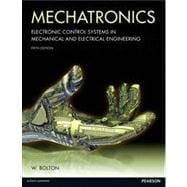Mechatronics is the integration of electronic engineering, mechanical engineering, control and computer engineering. From auto-focus cameras to car engine management systems, and from state-of-the-art robots to the humble washing machine, Mechatronics has a hand in them all.
This book presents a clear and comprehensive introduction to the area. It is practical and applied so it helps you to comprehend and design mechatronic systems. By also explaining the philosophy of Mechatronics it provides you with a frame of understanding to develop a truly interdisciplinary and integrated approach to engineering.
Mechatronics is essential reading for students requiring an introduction to this exciting area at undergraduate and higher diploma level.
- New Content includes:
An expanded first chapter gives a comprehensive introduction to the subject. - Includes more in-depth discussion of op-amps, mechanisms, and motor selection to improve clarity and extend applications.
- A new Appendix on Electrical Circuit Analysis is included to make the basic methods used for both d.c. and a.c. circuit analysis easily accessible to readers.








